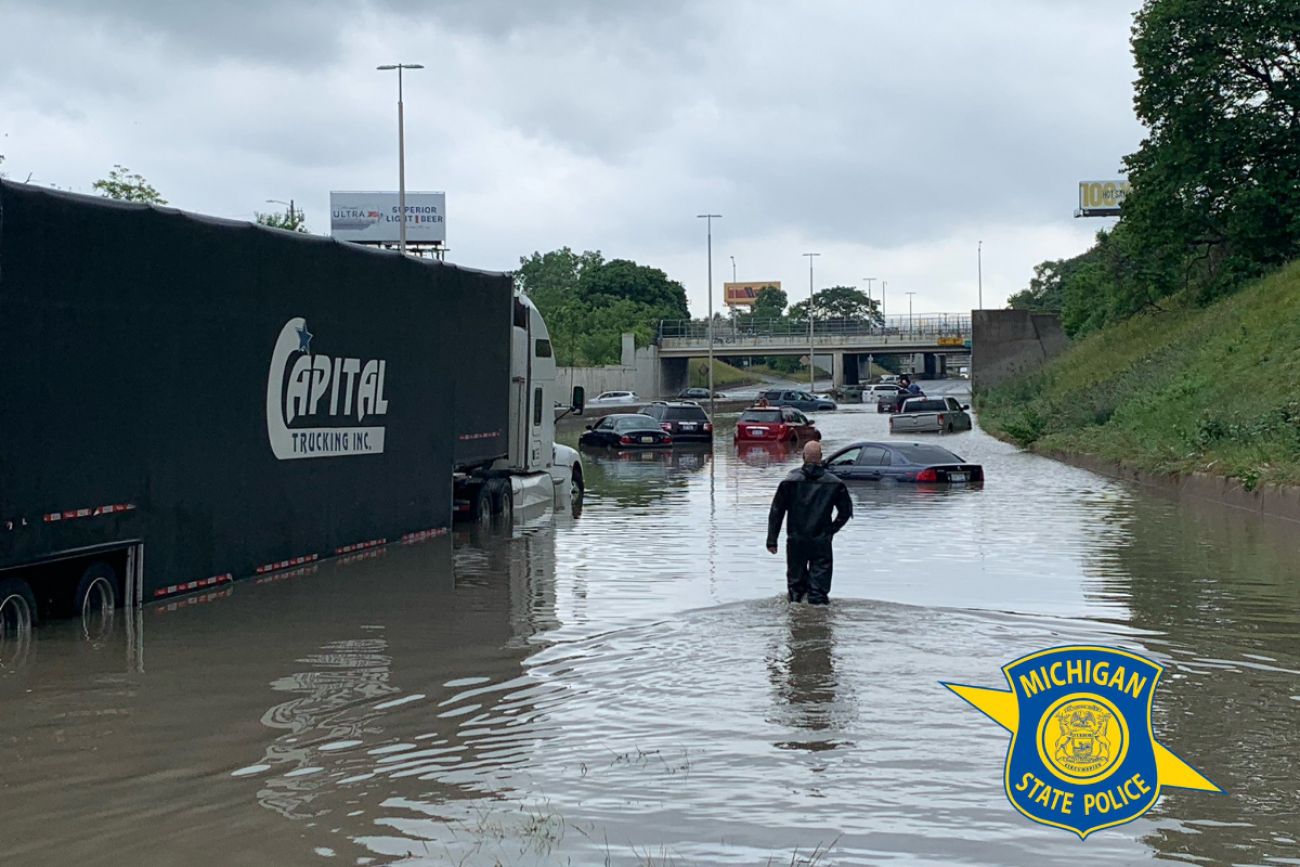Detroit-area floods mean sewage backups. Fed dollars won’t fix issue soon.

Despite the potential infusion of billions in federal infrastructure money, it could take years to see substantial improvements in southeast Michigan’s efforts to keep sewage back-ups out of basements after torrential rains.
Gov. Gretchen Whitmer said Monday that any infrastructure bills passed in Washington this summer won’t be enough to meet the state’s long-term needs for water infrastructure investment, as demonstrated by widespread flooding in much of Ann Arbor, Detroit, Dearborn and across the region following storms Saturday.
The Southeast Michigan Council of Governments estimates it will take $1 billion a year until 2045 to address storm water drainage alone — and that’s just in seven of the state’s 83 counties.
Related:
- Michigan flood waters, heat may have spiked Legionnaires’ disease
- Understanding why Detroit floods and why it keeps happening
- Reimbursement remains unclear for Detroit’s flood victims
- First person: Dearborn’s devastating flood exposes mistrust, deep divides
- Can Michigan become a climate haven? Duluth is already planning.
- In flooded Michigan neighborhoods, who should pay for sea walls?
That doesn’t account for the billions in other infrastructure needs, from drinking water and sewers to roads and bridges.
Federal estimates say fixes and updates to the nation’s water infrastructure system could cost $188 billion over the next 20 years, said Laura Rubin, director of the Healing Our Waters Great Lakes Consortium, which focuses on Great Lakes restoration issues. Michigan’s share of that is about $15 billion.
“That’s not even taking the disasters and increased precipitation into account,” Rubin said. “We know we’ve been under-investing in it.”
The infrastructure bill now under consideration in Congress would spend $1.2 trillion on a range of projects, including roads, bridges, broadband and public transportation. It would also include $55 billion toward water improvement.
Speaking in Detroit Monday, Whitmer said any sustainable fix must include long-term planning on both a federal and state level.
"Now we are seeing the cost of not fixing it and it would be overly simplistic to say that we should use one time dollars because this is an ongoing problem," Whitmer said at the media event, according to the Detroit Free Press.
Flooding and then no funding
Saturday’s heavy rains in Michigan brought another reminder of a problem that has plagued the region for decades. Although the official total was 2.3 inches recorded at Detroit City Airport, parts of some communities, including Detroit, Ann Arbor and Grosse Pointe, got 5 or more inches, with Wayne County’s Garden City getting nearly 7 inches.
Heavy rains have put so much pressure on sewage systems that water and sewage backed up into basements.
Metro Detroiters didn’t have to go back too far in their memories to recall similar events, notably in 2014.
Many municipalities and counties know what the problems are and how to solve them. The mystery ingredient, instead, is money: Finding enough of it to do the unsexy work of clearing sewer drains, plugging holes in sewer lines and building huge static detention ponds where needed.
“Clearly we don’t have enough money for the infrastructure improvements,” said Kathleen Lomako, former executive director of the Southeast Michigan Council of Governments. She now sits on the Michigan Infrastructure Council, which is working to coordinate infrastructure work across the state and among projects, like combining road work with storm water drainage.
Some of the work can be done quickly and have impact: Cleaning storm drains takes one person with a small tool and can mitigate road flooding that causes localized problems.
But bigger problems, like those along Ecorse Creek in southern Wayne County, require far more money. A 1988 report by the U.S. Army Corps of Engineers recommended spending just under $10 million — with $6.5 million from the federal government — to build a huge retention pond, equal in size to 123 Olympic swimming pools.
It never happened. A 2019 Corps report suggested the same solution with a far higher price tag of more than $21 million.
In between the two reports, floods occurred repeatedly and the Detroit law firm of Liddle & Dubin sued numerous downriver communities along the creek for flood damage in 1998, 2000, 2004, 2007 and 2010.
“Despite knowing all these problems and knowing what needs to be done, nothing gets done,” David Dubin, an attorney at the firm, told Bridge Michigan on Monday.
Yet if billions of new infrastructure money did pour into Michigan and other states, few say it could be spent quickly enough to mitigate the problems.
Projects would have to be designed and contractors hired. And with storm water, there is no built-in way for municipalities, counties and the state to pay for improvements. Attempts to create storm water drainage fees were limited by a Michigan Supreme Court decision in 1998.
Get used to more intense storms
Determining what’s wrong with clean water supplies and sewage treatment systems tend to be at the forefront of state and federal infrastructure planning, said Joe Bush, water resources commissioner for Ottawa County and president of the Michigan Association of County Drain Commissioners.
Stormwater management needs to join them on the priority list, Bush said. While some communities are looking at creating new wetlands to capture stormwater and others consider where larger scale-retention basins can be built, progress has been slow.
“People don’t recognize storm sewers as a big thing until you see what happened in Detroit on Saturday,” he said.
The problem, Bush said, is that heavy rain is treated like a critical issue when it floods an area, but as the water dries up so does the urgency to fix the underlying problem.
“When it comes and goes, it’s hard to spend the money on it,” Bush said. “But the damage in 24 hours … can rack up quickly with flooded homes and businesses.”
Whitmer has said she wants to see water issues, including infrastructure, addressed in the 2022 state budget.
In her MI Clean Water plan, proposed in October, she sought $293 million for wastewater initiatives. Among them: grants to help stop sewer overflows and improve stormwater management.
Weather changes with increased frequency and the intensity of rainfall adds urgency to the state’s stormwater initiatives, said Hugh McDiarmid, Jr. spokesperson for the Michigan Department of Environment, Great Lakes and Energy.
According to the U.S. Environmental Protection Agency, changing climate is likely to increase flooding in Michigan. While Midwest rainfall has increased 5-10 percent over the last 50 years, the EPA said, rainfall during the four wettest days of the year has increased about 35 percent.
“The more frequent, intense and volatile storms we’re seeing are surely going to become more common,” McDiarmid said. “Building resilience that factors climate-change effects into infrastructure projects is important.”
Seeing damage happening over and over again in some communities — like Dearborn, Dearborn Heights and the Jefferson Chalmers area on Detroit’s east side — frustrates U.S. Rep. Debbie Dingell, D-Dearborn.
“What’s happening now is simply unacceptable,” Dingell told Bridge Michigan. “And we need to understand why.”
As Congress negotiates with President Joseph Biden on the Bipartisan Infrastructure Framework bill, Dingell said communities will need the flexibility from the plan to target recurring system failures.
Dingell, who’s worked on water advocacy issues and added an accountability measure to America’s Water Infrastructure Act of 2018, said she’s pushing for an independent engineering study to determine the scope of the problem, which appears to stem from not just heavy downpours, but also blocked sewer drains and electrical outages that meant pumping stations could’t function properly.
There’s been a lack of will to invest in infrastructure over many years, Dingell said, and the costs have skyrocketed. Water utilities are funded by user fees, which means that available funding for fixes varies from place to place.
That’s a concern across Michigan, said Rubin, of Healing Our Waters, especially for lower-income areas that already face costs from removing lead service lines and enforcing state regulations for PFAS chemicals.
“Our utilities don’t have the money to pay for these problems,” she said.
That leaves the pending infrastructure bill as one area that could help to solve the stormwater issue. While this year flooding issues are mostly affecting southeast Michigan, in recent years the state’s high water table and Great Lakes water levels have pushed the issue onto shoreline communities and into low-lying agricultural areas.
Metro Detroit is bearing the brunt of it now, Dingell said, and she worries that if something isn’t done, flooding will continue to devastate neighborhoods every year or two.
“People living in my community have had it,” Dingell said. “They’re fed up.
“I see the damage,” Dingell said. “I see the flooded basements. I see the flooded highways. And something’s not right.”
Michigan Environment Watch
Michigan Environment Watch examines how public policy, industry, and other factors interact with the state’s trove of natural resources.
- See full coverage
- Subscribe
- Share tips and questions with Bridge environment reporter Kelly House
Michigan Environment Watch is made possible by generous financial support from:
Our generous Environment Watch underwriters encourage Bridge Michigan readers to also support civic journalism by becoming Bridge members. Please consider joining today.
See what new members are saying about why they donated to Bridge Michigan:
- “In order for this information to be accurate and unbiased it must be underwritten by its readers, not by special interests.” - Larry S.
- “Not many other media sources report on the topics Bridge does.” - Susan B.
- “Your journalism is outstanding and rare these days.” - Mark S.
If you want to ensure the future of nonpartisan, nonprofit Michigan journalism, please become a member today. You, too, will be asked why you donated and maybe we'll feature your quote next time!






